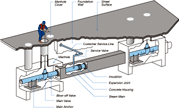10 March 2005
Central Heating
 One of the few redeeming qualities of winter in New York City are those beautiful columns of steam that rise from the streets. Walking along, you catch these great clouds of vapor churning and billowing — particularly at twilight, through the headlights and street lights.
One of the few redeeming qualities of winter in New York City are those beautiful columns of steam that rise from the streets. Walking along, you catch these great clouds of vapor churning and billowing — particularly at twilight, through the headlights and street lights.
So what’s it all about?
Under the streets of New York City is the largest steam distribution system in the world.
On March 3, 1882, the first steam distribution plant of importance in the U.S. made its first distribution of steam from a central plant at to the United Bank Building on Broadway, sending steam to heat buildings in lower Manhattan.
The New York Steam Corporation, formed July 26, 1880, consolidated with the Steam Heating and Power Company of New York in September 1881. The company was sold in 1915, but when the parent company went bankrupt two years later it was reorganized as the New York Steam Corporation. It was merged into the Consolidated Edison system in the 1930s.
This article from the Gotham Gazette’s infrastructure series draws the broad contours of the current steam system.
Seven steam plants, five in Manhattan and one each in Queens and Brooklyn generate the millions of pounds steam that run under the city’s streets. The steam heats housing, offices, a few churches, and NYC landmarks like the Empire State Building, the Metropolitan Museum of Art, and the United Nations. It is used to press your shirts and in the central sterilization unit St. Vincent’s Hospital. I also note that the system stops south of 96th street.
 Those plumes in the street may be releasing pressure or perhaps just a leak. The system moves steam at high pressures to maintain the temperature and push it through the system.
Those plumes in the street may be releasing pressure or perhaps just a leak. The system moves steam at high pressures to maintain the temperature and push it through the system.
Three of the plants simultaneously produce both steam and electricity through a process called co-generation. At the height of winter, the system sends out nearly 10 million pounds of steam per hour. Sales from ConEd’s Steam Business Unit account for about 7 percent of total Con Edison revenues.
And because the steam is mass-produced, it is more economical, efficient, and environmentally friendly than the hundred thousand individual oil or gas boilers it replaces. Centralized steam eliminates the need for boilers in individual buildings along with million gallons of heavy fuel oil and traffic from fuel delivery trucks. The steam plants use low sulfur oil or clean-burning natural gas to produce steam. High tech burners further lower nitrogen oxide emissions.
Update 1/9/2010: Here’s a great piece on Urban Omnibus about the NYC steam system.

